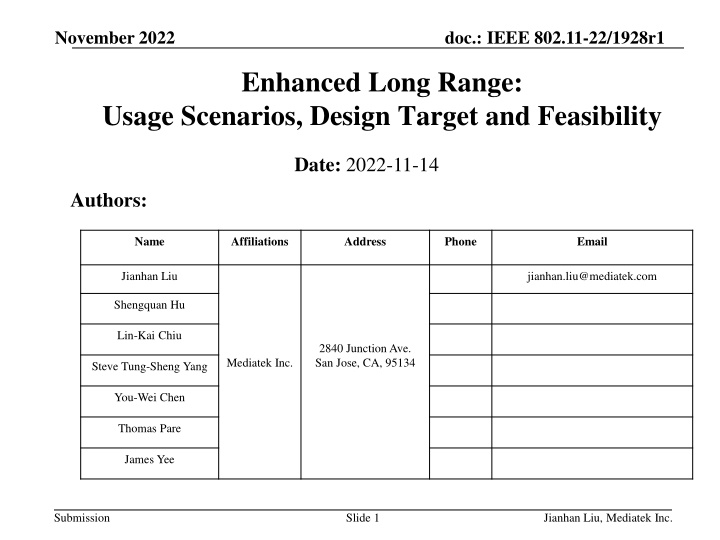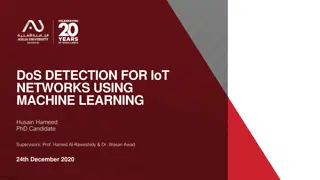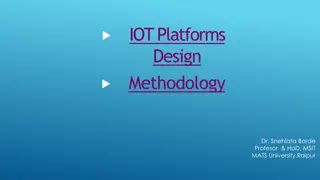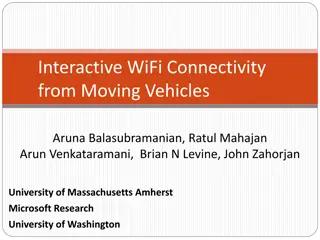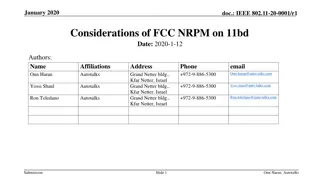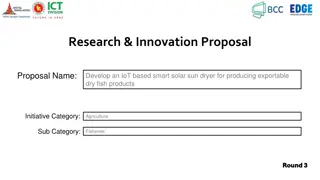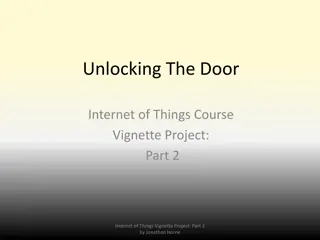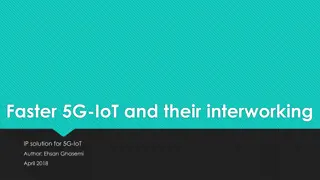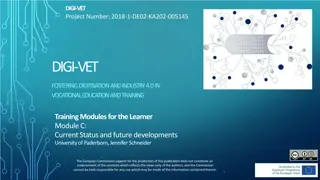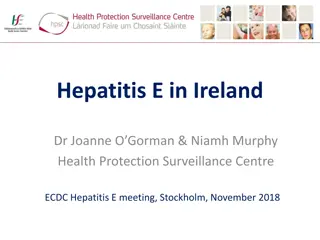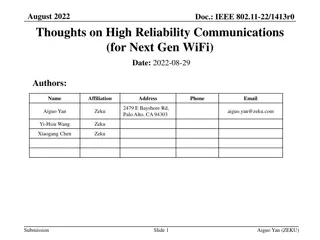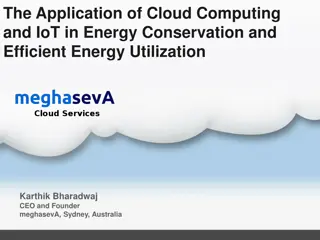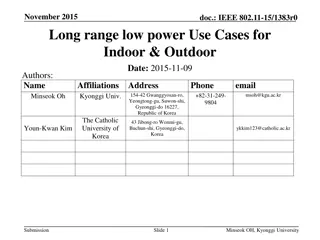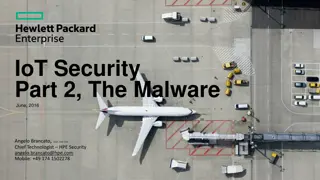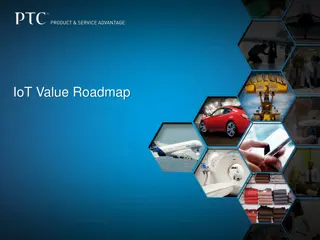Enhanced Long Range WiFi Solutions for IoT and Video Surveillance Applications
Outdoor IoT and certain indoor applications require enhanced long-range WiFi solutions for improved efficiency and compatibility. Features like relay using multi-AP can extend ranges but are not cost-effective. The booming home security camera market also necessitates enhanced long-range solutions to address range limitations in outdoor wireless video surveillance scenarios. It's time to develop a new generation of long-range solutions to replace outdated technologies like 11b and enhance performance and manageability.
Download Presentation

Please find below an Image/Link to download the presentation.
The content on the website is provided AS IS for your information and personal use only. It may not be sold, licensed, or shared on other websites without obtaining consent from the author.If you encounter any issues during the download, it is possible that the publisher has removed the file from their server.
You are allowed to download the files provided on this website for personal or commercial use, subject to the condition that they are used lawfully. All files are the property of their respective owners.
The content on the website is provided AS IS for your information and personal use only. It may not be sold, licensed, or shared on other websites without obtaining consent from the author.
E N D
Presentation Transcript
November 2022 doc.: IEEE 802.11-22/1928r1 Enhanced Long Range: Usage Scenarios, Design Target and Feasibility Date: 2022-11-14 Authors: Name Affiliations Address Phone Email Jianhan Liu jianhan.liu@mediatek.com Shengquan Hu Lin-Kai Chiu 2840 Junction Ave. San Jose, CA, 95134 Mediatek Inc. Steve Tung-Sheng Yang You-Wei Chen Thomas Pare James Yee Submission Slide 1 Jianhan Liu, Mediatek Inc.
November 2022 doc.: IEEE 802.11-22/1928r1 Needs of Enhanced Long Range (ELR) Solutions Outdoor IoT applications and some indoor applications need a longer range, more efficient and better compatible WiFi solution. For example, wireless video doorbells, outdoor surveillance cameras, wireless garage door controllers, outdoor sprinkler controllers, wireless speakers, smart appliances and security IoT devices, etc. Relay using multi-AP can enhance ranges. But it is not a cost-effective solution and therefore only suitable for high-data rate and relatively expensive applications. Most IoT applications are cost sensitive. It is not a good selling point to require customer to buy an extra relay to connect a much cheaper IoT device. Other solutions like 11ah suffer non-uniform regulatory issues and have difficulty to be widely adopted. Submission Slide 2 Jianhan Liu, Mediatek Inc.
November 2022 doc.: IEEE 802.11-22/1928r1 Booming of home security camera market Most home video surveillance includes indoor and outdoor cameras. One of the biggest obstacles for outdoor wireless video surveillance is the lack of range. According to Grand View Research, the global smart home security camera market size was valued at USD 3.71 billion in 2019 and is expected to grow at a compound annual growth rate (CAGR) of 15.7% from 2020 to 2027. Enhanced long range WiFi solutions are in dire need to empower the wireless video doorbell and wireless video surveillance scenarios. Submission Slide 3 Jianhan Liu, Mediatek Inc.
November 2022 doc.: IEEE 802.11-22/1928r1 Enhanced Long Range (ELR) as Next Gen of 11b 11b is the only long-range solution from WiFi industry. Some facts about it: 11b is still widely used. 11b devices are hard to manage, with poor performance and poor forward combability. 11b was published in 1999, it is over 2 decades old with outdated technologies. 11b even has no channel coding (the most important technology in modern wired and wireless communications). It is time to design a new generation of enhanced long range solution to reinvigorate applications that still rely on 11b technology. We can introduce channel coding, OFDM/OFDMA into the new generation long range solution to obtain longer range and higher data rates. We can also introduce advanced MAC features to achieve better manageability, better power save and higher network efficiency. Submission Slide 4 Jianhan Liu, Mediatek Inc.
November 2022 doc.: IEEE 802.11-22/1928r1 Why can we not use UL TB PPDU with small RU as the ELR solution? The assumptions: Assume an AP can transmit at higher power, say 6dB, than STA. So Trigger can be transmitted with higher power and hence reach longer range. STA uses a 26-tone or a 52-tone RU in UL TB PPDU to achieve longer range by concentrating its power in narrow bandwidth. No preamble processing for UL TB PPDU, just processing EHT- STF and EHT-LTF and data portion. Because the preamble of UL TB PPDU is at least 20MHz, it can not be received by the AP at such long range. Submission Slide 5 Jianhan Liu, Mediatek Inc.
November 2022 doc.: IEEE 802.11-22/1928r1 Why can t we use UL TB PPDU with small RU as the ELR solution? Firstly, even if we can use UL TB PPDU with small RU to extend range, we can not solve the non-trigger transmissions. For example, how can an ELR STA send an association request to the AP? How can an ELR STA send data without AP s trigger? Secondly, use of UL TB PPDU with small RU can at most extend range by a few dBs, taking into account the transmit power difference between AP and STA. We can not reach 9-10dB enhanced long range using UL TB PPDU with small RU. Thirdly, for long range transmissions, the received SNR of trigger frame is very low. The frequency offset estimation and timing synchronization are not accurate. Therefore, UL TB PPDU can have large frequency offset and timing error. Our simulation shows 1.5-2dB performance loss due to FO estimation errors in low SNR in UL TB PPDU. Submission Slide 6 Jianhan Liu, Mediatek Inc.
November 2022 doc.: IEEE 802.11-22/1928r1 Why can t we use UL TB PPDU with small RU as the ELR solution? Lastly, and most importantly, UL TB PPDU with small RU can not be used to extend range in regions outside the USA due to PSD limitations. To meet all the regulations, the maximum power of RU52 (~4MHz) and RU26 (~2MHz) cannot exceed 16 dBm and 13 dBm, respectively. Even if we assume AP can transmit at much higher power using 20MHz trigger, the UL TB still can not extend range. Submission Slide 7 Jianhan Liu, Mediatek Inc.
November 2022 doc.: IEEE 802.11-22/1928r1 Comparisons of Wireless Long Range Solutions To set the design target of UHR ELR, we compare the range of different long-range solutions in WLAN and WPAN. The achievable path loss can be translated to range directly. We can see that: 11b reaches shorter range than BT BLR and ZigB. 11g reaches 6dB shorter range than 11b. 2.4GHz WiFi 11b CCK 1mbps WiFi 11g OFDM 6mbps BT BLR ZigB Data BWs 11MHz 20MHz 1MHz ~1.5MHz Data Rate 1mbps 6mbps 0.125mbps 0.25mbps AWGN: 122.5dB AWGN: 117dB AWGN: 126dB AWGN: 124.5dB * Achievable Path Loss * Achievable Path loss = TX Power RX Sensitivity + Antenna Gain TX/RX Implementation loss Submission Slide 8 Jianhan Liu, Mediatek Inc.
November 2022 doc.: IEEE 802.11-22/1928r1 Design Targets of ELR ELR should reach longer range at similar data rate of 11b OR higher data rate at similar range. At similar or lower TX power compared to 11b, it is desirable to achieve longer range than 11b at same data rate, say, 1Mbps. We set the target of ELR to improve the range at 1Mbps by about 9-10 dB compared to 11g at 6Mbps, about 3-4dB improvement compared to 11b at 1Mbps. Note that ELR can support other rates besides 1Mbps. Make ELR a competitive long-range solution against other wireless solutions such as BT and ZigB. We also would like ELR to support OFDMA for higher efficiency and support TWT and other good MAC features. Submission Slide 9 Jianhan Liu, Mediatek Inc.
November 2022 doc.: IEEE 802.11-22/1928r1 More Justifications on Design Target of ELR Design target of ELR to improve the range at 1Mbps by about 9-10 dB compared to 11g at 6Mbps, about 3-4dB improvement compared to 11b at 1Mbps. This design target can make ELR be able to reach the same or longer range than Zigbee or BT-BLR. Thus, WiFi industry can also provide solutions to wireless applications requiring longer coverage. If AP transmits 11b beacon and AP has 6dB higher transmit power, then ELR s extra 3-4dB improvement over 11b can narrow down the downlink and uplink coverage imbalance to 2-3dB. Due to the limited transmit power density in 2.4GHz in many regions (such as EU, China, Japan and Korea), the total transmit power is limited for 11b (11MHz) is 3dB smaller than in US and thus 3dB shorter coverage. An additional 3-4dB improvement in these regions can make the coverage at least on par with the current coverage in US. Submission Slide 10 Jianhan Liu, Mediatek Inc.
November 2022 doc.: IEEE 802.11-22/1928r1 Feasibility of ELR Design We did some feasibility study of ELR design with 1Mbps. With simple repetition schemes on preamble and data filed and channel coding, we can see that UHR ELR can achieve 10dB longer range than 11g at 6Mbps and 4dB longer range than 11b at 1Mbps. 11b 1Mbps 11g 6Mbps 11ax ER RU242+DCM (LDPC) UHR ELR PHY Rate 1Mbps 6Mbps 4Mbps 1Mbps 2.4G TX power (dBm) X X-2 X-2 X-2 RX Sensitivity (dBm) ENL: Y UMi: Z ENL: Y+4 UMi: Z+3 ENL: Y+2 UMi: Z+1 ENL : Y-6 UMi : Z-5 Achievable Path Loss * (dB) ENL: 118 UMi: 114 ENL: 112 UMi: 109 ENL: 114 UMi: 111 ENL: 122 UMI: 117 Submission Slide 11 Jianhan Liu, Mediatek Inc.
November 2022 doc.: IEEE 802.11-22/1928r1 Summary We address the needs and usage scenarios of Enhanced Long Range (ELR) Solutions. Cost-effective long range solutions for wireless video doorbells, outdoor surveillance cameras, wireless garage door controllers, outdoor sprinkler controllers, wireless speakers, smart appliances and security IoT devices, etc. Enhanced Long Range (ELR) as Next Generation of long range solution replacing 11b. Current long range schemes in 11ax/11be can not meet the long range needs. We propose the design target for ELR at 1Mbps, which reaches 9- 10dB longer range than 11g at 6Mbps (3-4dB longer range than 11b at 1Mbps). Lastly, we showed that ELR design target can be easily reached. Submission Slide 12 Jianhan Liu, Mediatek Inc.
November 2022 doc.: IEEE 802.11-22/1928r1 Straw Poll Do you agree that Enhanced Long Range should be considered as a feature for the UHR SG proposed PAR? Submission Slide 13 Jianhan Liu, Mediatek Inc.
